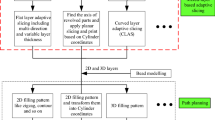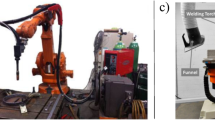Abstract
This article presents a spherical slicing method for additive manufacturing (AM) which is used to lay additive layers on a spherical surface, thus removing the stair stepping effect, increasing structural integrity and tensile strength. A toolpath is required to guide the extruder in the three-dimensional space and deposit the material in the desired locations. These tool paths are computed using slicing algorithms. The well-established method in AM industry is the planar slicing. In this method, the Computer Aided Design model is sliced using planes and as a result, two-dimensional tool paths are formed. With the introduction of multi-axis AM machines, development of new non-planar slicing algorithms has started. In this article, a novel non-planar, spherical slicing, is introduced. In the proposed spherical slicing method, the model is sliced by spherical shells such as that of an onion. These spherical slices are then used to generate the appropriate tool paths for guiding the robotic manipulator in three-dimensional space together with the corresponding orientation to lay the spherical layers on top of the previously manufactured planar base. Results are verified by manufacturing a model using a six-axis robotic serial manipulator by fused deposition modeling.





Similar content being viewed by others
References
Gao W, Zhang Y, Ramanujan D et al (2015) The status, challenges, and future of additive manufacturing in engineering. Comput Des 69:65–89. https://doi.org/10.1016/j.cad.2015.04.001
Kellner T (2014) World’s first plant to print jet engine nozzles in mass production. GE Reports
Bianconi F (2002) Bridging the gap between CAD and CAE using STL files. Int J CAD/CAM 2:55–67
Materialise T (2018) Materialise slicing technology enables Toyota’s lightweight car seat. https://www.materialise.com/en/cases/materialise-slicing-technology-enables-toyota’s-lightweight-car-seat. Accessed 19 Nov 2019
Onuh SO, Yusuf YY (1999) Rapid prototyping technology: applications and benefits for rapid product development. J Intell Manuf 10:301–311. https://doi.org/10.1023/A:1008956126775
Pandey PM, Reddy NV, Dhande SG (2003) Slicing procedures in layered manufacturing: a review. Rapid Prototyp J 9:274–288. https://doi.org/10.1108/13552540310502185
Llewellyn-Jones T, Allen R, Trask R (2016) Curved layer fused filament fabrication using automated toolpath generation. 3D Print Addit Manuf. https://doi.org/10.1089/3dp.2016.0033
Yigit IE, Lazoglu I (2019) Helical slicing method for material extrusion-based robotic additive manufacturing. Prog Addit Manuf 4:225–232. https://doi.org/10.1007/s40964-019-00090-w
Yerazunis WS, Barnwell JCI, Nikovski DN (2016) Strengthening ABS, nylon, and polyester 3D printed parts by stress tensor aligned deposition paths and five-axis printing. Solid Free Fabr Symp. https://doi.org/10.1021/acsnano.6b02108
Zhao G, Ma G, Feng J, Xiao W (2018) Nonplanar slicing and path generation methods for robotic additive manufacturing. Int J Adv Manuf Technol. https://doi.org/10.1007/s00170-018-1772-9
Tsao C, Chang H, Liu M et al (2018) Freeform additive manufacturing by vari-directional vari-dimensional material deposition. Rapid Prototyp J 24:379–394. https://doi.org/10.1108/RPJ-01-2017-0014
Singamneni S, Roychoudhury A, Diegel O, Huang B (2012) Modeling and evaluation of curved layer fused deposition. J Mater Process Technol 212:27–35. https://doi.org/10.1016/j.jmatprotec.2011.08.001
Lim S, Buswell RA, Valentine PJ et al (2016) Modelling curved-layered printing paths for fabricating large-scale construction components. Addit Manuf 12:216–230. https://doi.org/10.1016/j.addma.2016.06.004
Allen RJA, Trask RS (2015) An experimental demonstration of effective curved layer fused filament fabrication utilising a parallel deposition robot. Addit Manuf 8:78–87. https://doi.org/10.1016/j.addma.2015.09.001
Michael K, Georg Ernst PO (2005) Tool path generation for 3D laser cladding using adaptive slicing technology. Proc Int Congr Appl Lasers Electro-Opt 604:310–319
Ding Y, Dwivedi R, Kovacevic R (2017) Process planning for 8-axis robotized laser-based direct metal deposition system: a case on building revolved part. Robot Comput Integr Manuf 44:67–76. https://doi.org/10.1016/j.rcim.2016.08.008
Adams JJ, Duoss EB, Malkowski TF et al (2011) Conformal printing of electrically small antennas on three-dimensional surfaces. Adv Mater 23:1335–1340. https://doi.org/10.1002/adma.201003734
Evans B (2012) Practical 3D printers: the science and art of 3D printing. Apress
Möller T, Trumbore B (1997) Fast, minimum storage ray-triangle intersection. J Graph Tools 2:21–28. https://doi.org/10.1080/10867651.1997.10487468
Watt A, Watt M (1992) Advanced animation and rendering techniques: theory and practice. Addison Wesley Publishing Company, New York
Acknowledgements
This research was supported by the Koc University Manufacturing and Research Center.
Author information
Authors and Affiliations
Corresponding author
Ethics declarations
Conflict of interest
On behalf of all authors, the corresponding author states that there is no conflict of interest.
Additional information
Publisher's Note
Springer Nature remains neutral with regard to jurisdictional claims in published maps and institutional affiliations.
Rights and permissions
About this article
Cite this article
Yigit, I.E., Lazoglu, I. Spherical slicing method and its application on robotic additive manufacturing. Prog Addit Manuf 5, 387–394 (2020). https://doi.org/10.1007/s40964-020-00135-5
Received:
Accepted:
Published:
Issue Date:
DOI: https://doi.org/10.1007/s40964-020-00135-5




